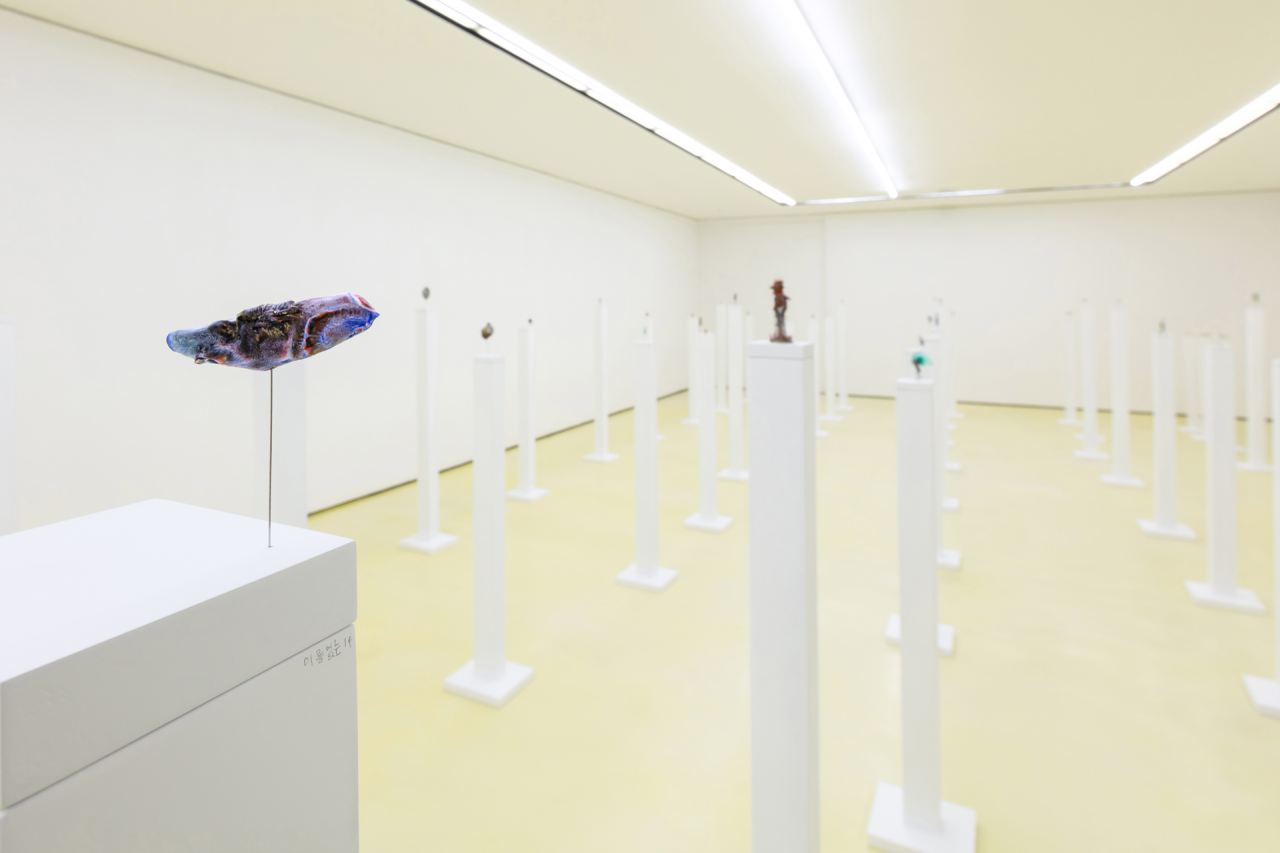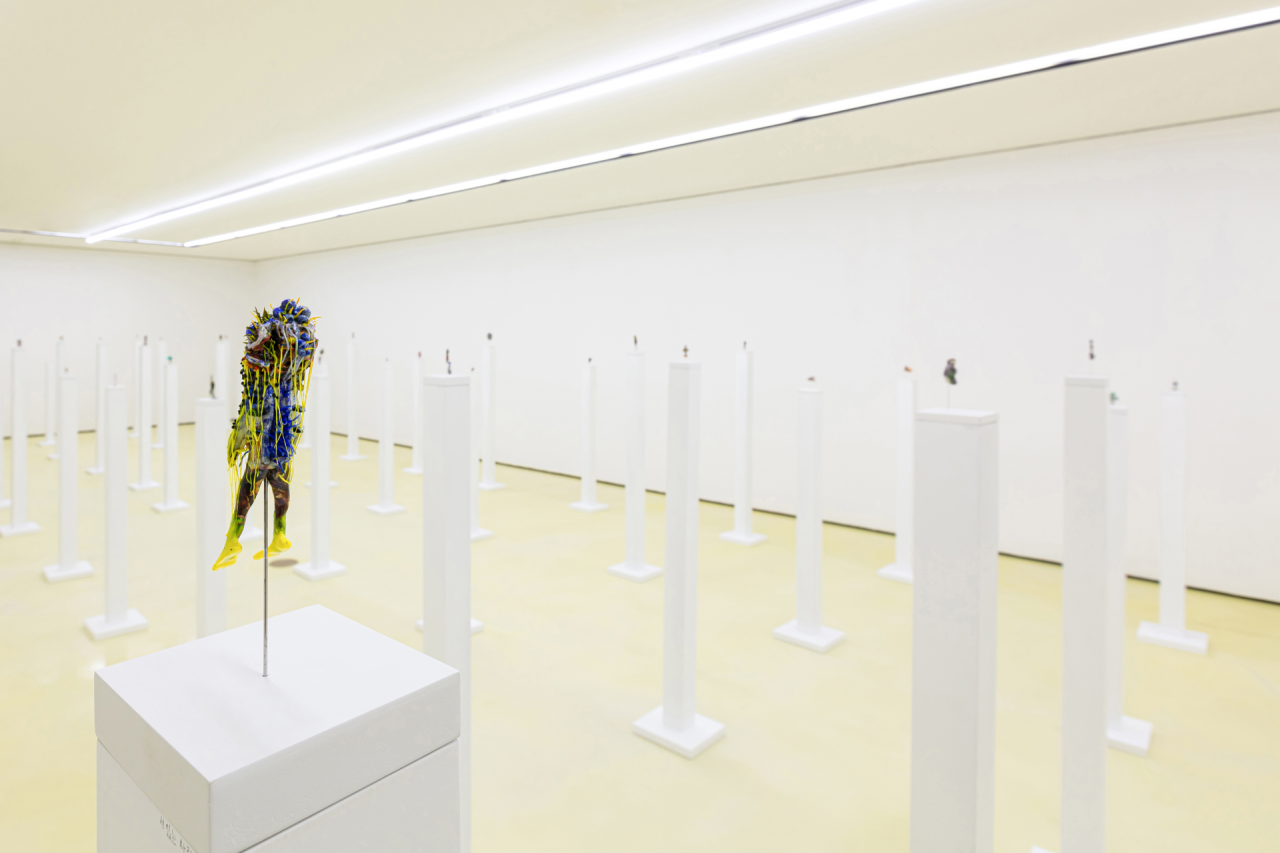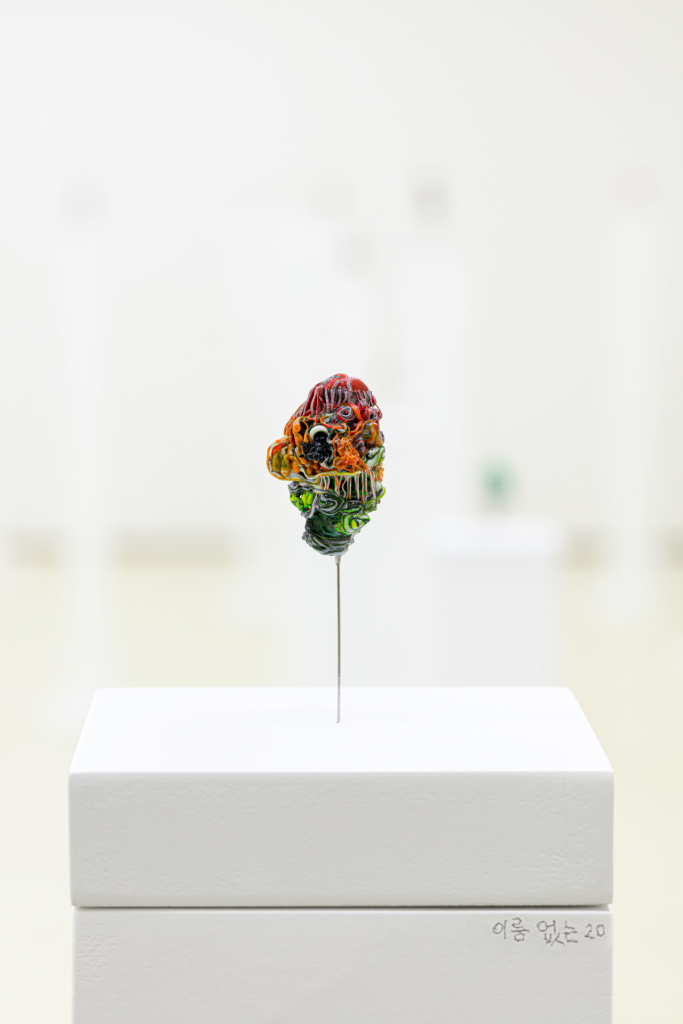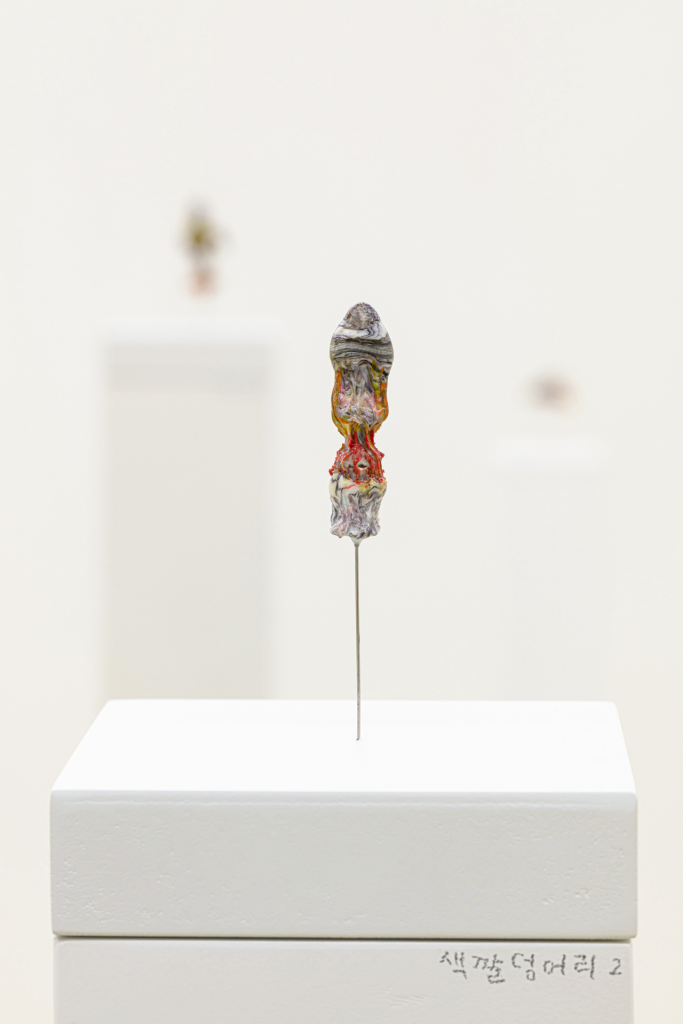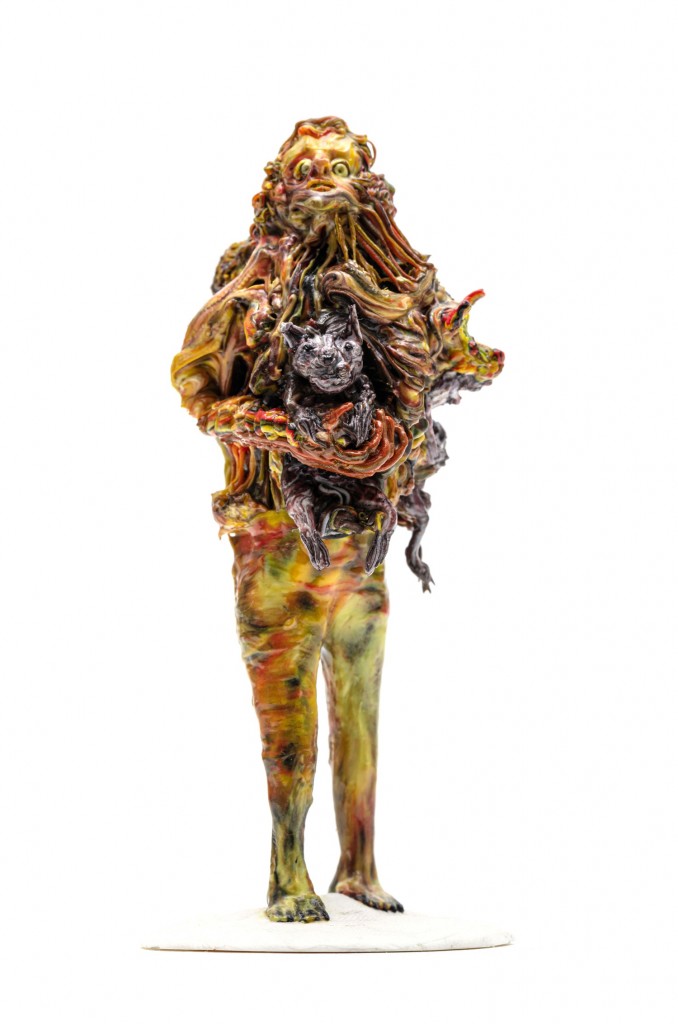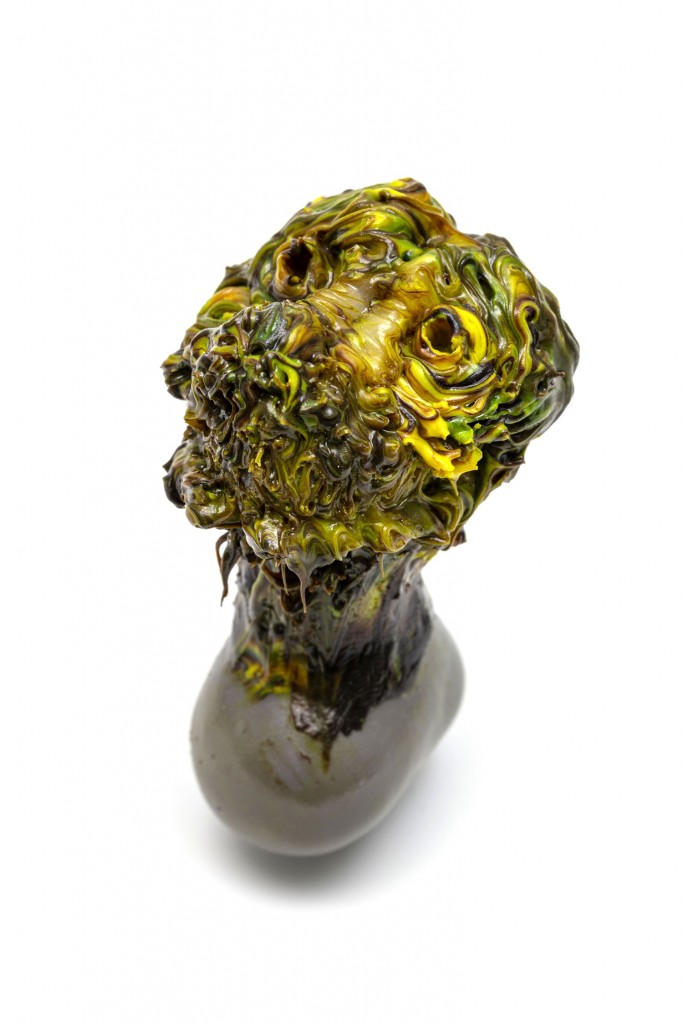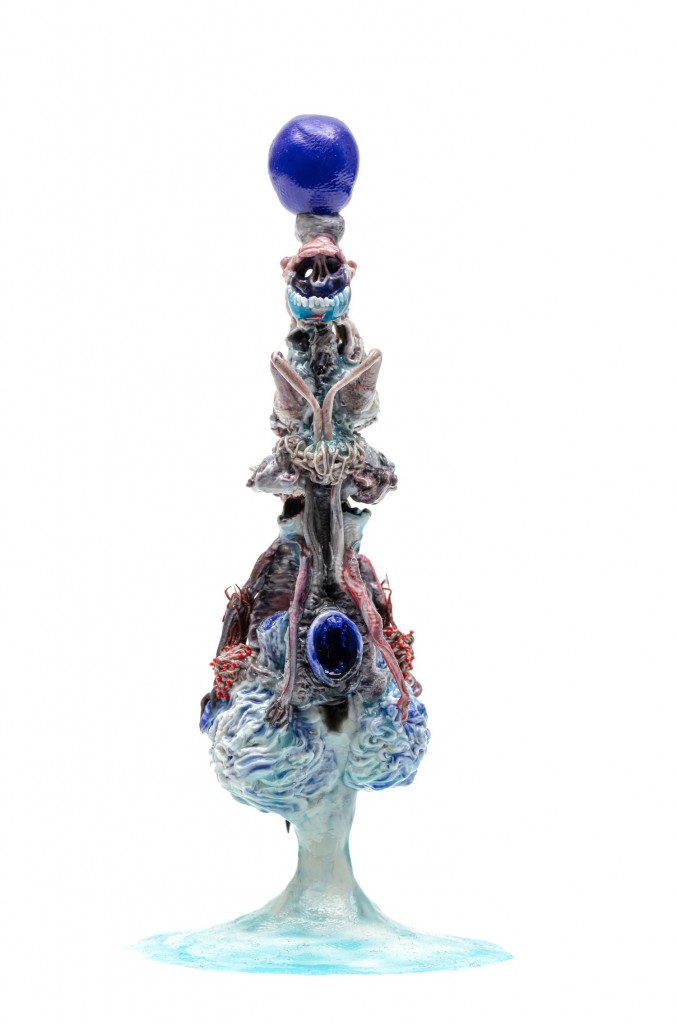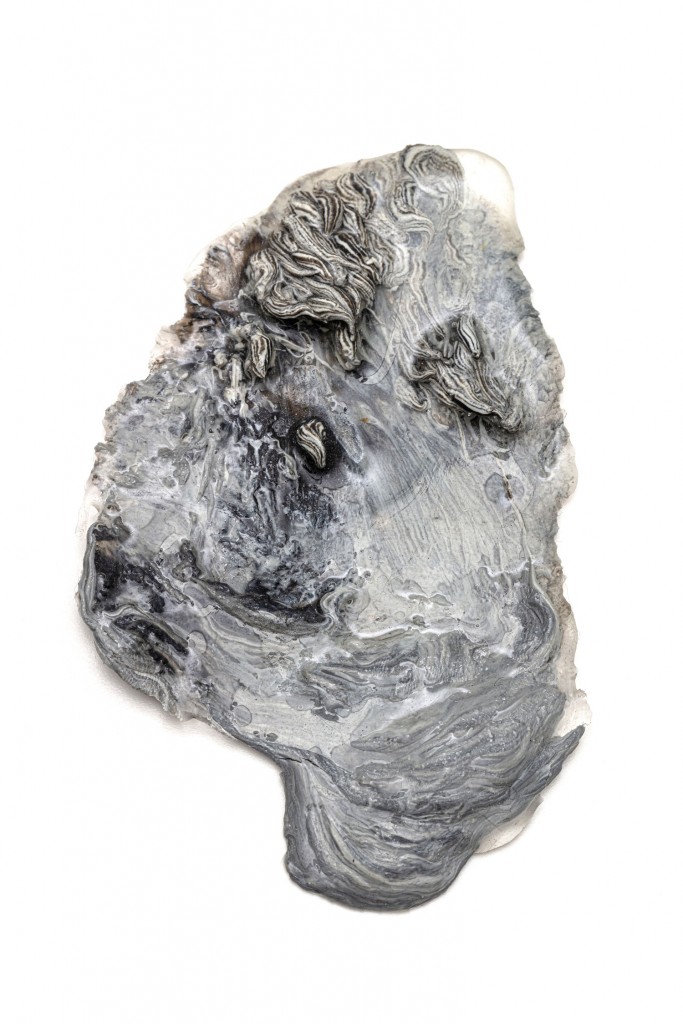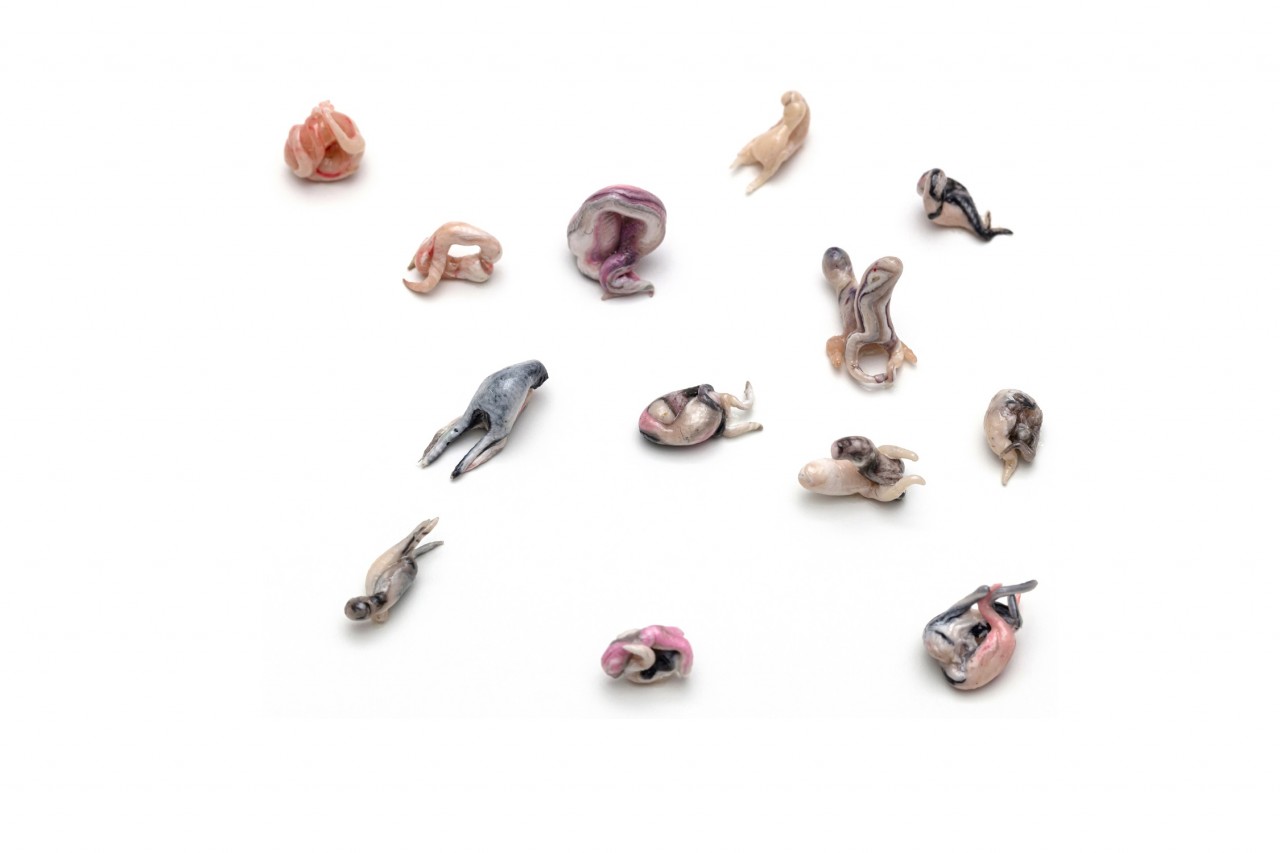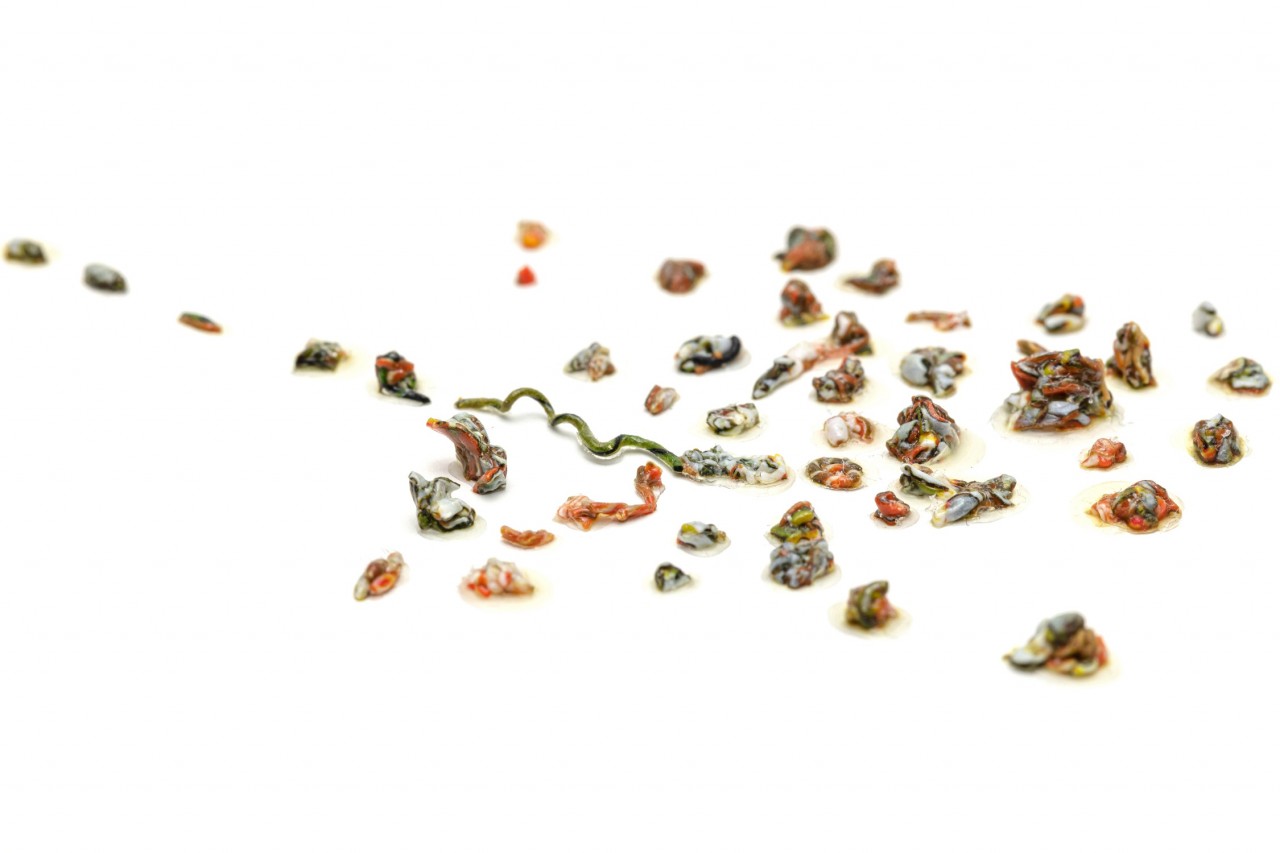Exhibitions
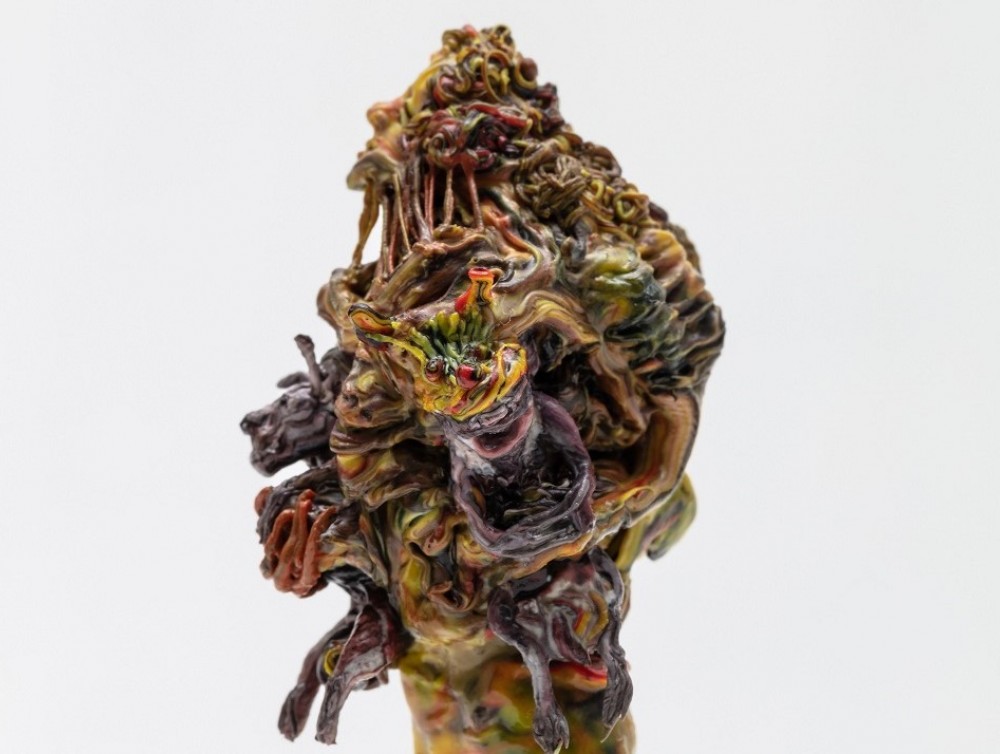
PERIGEE ARTIST #29 함진
엄마
2022.09.23. FRI ~
2022.11.12. SAT
<천의 얼굴을 드러내는 손끝>
신승오 (페리지갤러리 디렉터)
함진은 초기 작업에서 초소형 인물을 실제의 사물들과 함께 배치함으로써 우리가 살아가는 현실을 풍자적으로 표현하였다. 이후의 작업에서는 검정의 단색으로 이루어진 추상적인 형상으로 연결된 작품을 통해 자신만의 조형감각을 보여주었다. 그리고 최근에는 이전의 단색으로 이루어진 작업에서 벗어나 색이 다채롭게 드러나는 작업을 해오고 있다. 이번 개인전인 《엄마》에서도 그는 여러 형태와 색을 가진 입체 작업을 선보인다. 본 글에서는 이러한 작업에서 그가 작품을 만들어 나가는 방식을 먼저 살펴보고 작가가 여전히 고수하고 있는 것과 새롭게 시도하고 있는 것을 알아보고자 한다. 이후에는 그의 작품의 표면에 나타나는 것에 집중하면서 작가의 작업적 태도의 흔적을 따라갈 예정이다. 그리고 이러한 과정에서 이번 작품들의 변화와 그것이 가지는 본질적인 의미를 자연스럽게 이해할 수 있으리라 생각한다.
먼저 함진이 작업을 만들어 나가는 방식은 단순하다. 그는 색깔 점토(폴리머클레이)를 주재료로 사용한다. 이 점토의 특성은 별다른 도구 없이 손으로 조물조물 누르고 뒤섞어 압축하고, 다시 늘려서 펴고, 이들을 연결하여 붙이는 과정을 통해 무엇인가를 쉽고 자연스럽게 만들어 낼 수 있는 편리함으로 가지고 있다. 그가 이 재료를 고집하는 이유는 특별한 도구 없이 자기 손으로 온전히 다루기 용이하기 때문이다. 이렇게 작가에게 있어서 이....
Fingertips Unmasking a Thousand Faces
Seung Oh Shin (Director of Perigee Gallery)
Ham Jin’s early work was a satirical portrayal of our reality with subminiature figures arranged with real things. Afterwards, Ham showcased his own distinctive modeling idioms through a connection of black monochrome abstract images. He has recently been working on disclosing a broad spectrum of colors, breaking away from his previous monochrome practice. On show at this exhibition Mom are three-dimensional pieces characterized by a diversity of forms and hues. This essay will be a review of such practices as well as an investigation of what he still sticks to and what he attempts newly. This study will also look into his artistic attitude, focusing primarily on what appears on the surface of his work. I think changes in such works and their elemental meaning can be naturally understood in this process.
Ham has relied on simplicity in making his pieces. The main material of his work is polymer clay. The salient feature of this material is malleability or convenience that enables one to make something naturally and easily by a p....
신승오 (페리지갤러리 디렉터)
함진은 초기 작업에서 초소형 인물을 실제의 사물들과 함께 배치함으로써 우리가 살아가는 현실을 풍자적으로 표현하였다. 이후의 작업에서는 검정의 단색으로 이루어진 추상적인 형상으로 연결된 작품을 통해 자신만의 조형감각을 보여주었다. 그리고 최근에는 이전의 단색으로 이루어진 작업에서 벗어나 색이 다채롭게 드러나는 작업을 해오고 있다. 이번 개인전인 《엄마》에서도 그는 여러 형태와 색을 가진 입체 작업을 선보인다. 본 글에서는 이러한 작업에서 그가 작품을 만들어 나가는 방식을 먼저 살펴보고 작가가 여전히 고수하고 있는 것과 새롭게 시도하고 있는 것을 알아보고자 한다. 이후에는 그의 작품의 표면에 나타나는 것에 집중하면서 작가의 작업적 태도의 흔적을 따라갈 예정이다. 그리고 이러한 과정에서 이번 작품들의 변화와 그것이 가지는 본질적인 의미를 자연스럽게 이해할 수 있으리라 생각한다.
먼저 함진이 작업을 만들어 나가는 방식은 단순하다. 그는 색깔 점토(폴리머클레이)를 주재료로 사용한다. 이 점토의 특성은 별다른 도구 없이 손으로 조물조물 누르고 뒤섞어 압축하고, 다시 늘려서 펴고, 이들을 연결하여 붙이는 과정을 통해 무엇인가를 쉽고 자연스럽게 만들어 낼 수 있는 편리함으로 가지고 있다. 그가 이 재료를 고집하는 이유는 특별한 도구 없이 자기 손으로 온전히 다루기 용이하기 때문이다. 이렇게 작가에게 있어서 이전에서부터 지금까지 아주 작은 세밀한 작업을 하기 위해 사용되는 도구는 손이다. 좀 더 명확하게 이야기하자면 손바닥이나 손가락 전체가 아니라 손끝이다. 조각에서 소조의 방식이 재료를 손으로 다루어 일반적으로 말하는 손맛을 통해 작가의 창작 행위의 흔적을 찾아볼 수 있듯이 그의 작업에서 작가의 흔적을 쉽게 발견할 수 있다. 우선 그는 다양한 색의 점토를 조금씩 떠내어 두 손가락으로 비벼서 뒤섞는다. 그리고 이를 넓게 펼쳐서 가느다란 철사 혹은 나무 꼬챙이와 같은 기본적인 뼈대에 붙인다. 그 이후에는 이러한 과정을 반복하면서 손으로 붙이고 늘리고 바늘과 같은 도구로 찌르고, 밀고, 당기면서 형태를 만들어 나간다. 마지막으로 이것을 구워서 고정한다. 이와 같은 작업 방식에 특별한 규칙은 존재하지 않는다. 이는 온전히 자신의 손가락 끝과 점토가 만나 접촉하는 감각과 함께 이를 보는 시각이 혼재된 그 찰나적 순간에 따라 달라진다. 단지 작가는 점토가 결합하면서 변해가는 조형의 형태에 따라 본능적으로 어떤 방향으로 나아갈지 선택할 뿐이다. 여기에 더해 다양한 색을 가진 점토를 사용하여 이제는 단순한 덩어리로서의 형태에 머무는 것이 아니라 여러 층위로 뒤섞여 자연스럽게 드러나는 색의 무늬까지 감각적인 선택의 결정 요소로 작용하고 있다. 또한 그는 자신의 지문이 남는 것조차 조형 형태의 한 요소로 인식하여 남길지 지워버릴지 고민하는 강박적인 집착도 있지만, 순식간에 작업을 마무리하는 느슨한 태도도 보여준다. 이와 같은 변화는 그의 작업에서 좀 더 복잡하고 다채로운 형태들을 펼쳐나가는 계기로 작용하며, 이전보다 세밀한 선택적 표현으로 인하여 전체적인 형태와 더불어 작품의 추상적 표면에도 시선을 집중하게 만든다. 이렇게 근작에서 나타나는 다분히 즉흥적이면서도 직관적인 색과 형태로 이루어진 형상들은 구상적인 것과 추상적인 것들이 공존하는 작업으로 나타난다.
이제는 작품들로 이야기를 옮겨보자. 그가 만드는 작품들에서 보이는 것은 인물, 동물, 미물, 나무와 같은 생명체와 돌, 액체와 같은 무생물을 포함하여 다양하다. 이는 단독으로 어떤 대상이 되기도 하고, 추상적인 풍경으로 보이기도 한다. 이렇게 다양한 존재들은 어떤 세상을 창조하고자 하는 작가의 의지에 기인한다. 위에서 살펴본 제작방식에서 알 수 있듯이 그가 지속해서 유지하고 있는 작업의 재료와 제작 방식은 작가에게 있어 신이 세상을 창조하는 것과 같이 전지전능한 능력을 획득하기 위한 것처럼 보인다. 그렇기에 전시 제목인 《엄마》는 말 그대로 엄마이기도 하면서 모성, 생명력, 창조성, 자연을 상징하는 대지모신(大地母神)의 의미로 읽힌다. 인간사회는 대(代)를 통해 이어진 자연의 생명력에 더해 신에 의한 세상이 창조되었다는 신화를 잉태하였다. 신화는 인간의 범위를 넘어서 존재하는 초월적인 힘에 대해 스스로 만들어낸 현실과 걸쳐진 또 다른 생명체로 가득한 세계이다. 따라서 신화의 시공간은 가상의 세계에만 머무는 것이 아니라 이러한 이야기의 증거로서 자연의 대상물에 이름을 남기거나 증거가 되는 흔적들을 남겨 놓는다. 이렇게 세계 창조에 대한 신화는 종교와 이야기를 통해 끊임없이 후대로 이어지며 현재에 이르고 있다. 하지만 작가의 작업에서 보이는 신화적 상상은 신화에 등장하는 구체적인 등장인물이 겪는 고난과 같은 사건 이면에 존재하는 이야기보다는 자신에게서 기원하는 개인적 경험에 기반한 신화이다. 그는 기존의 세상에 없던 존재를 새로이 만들고 원래의 것을 완전히 재창조해 내는 창작의 행위를 중요시할 뿐이다. 물론 나의 내부로부터 나오는 것이 온전히 나만의 것이라고 볼 수는 없다. 태어나기 전부터 맺어진 수많은 부모와의 연결된 인연 그리고 무형적으로 전달된 많은 사회, 문화적 정보들로 조합되어 이루어진 것이 지금의 ‘나’이다. 여기에 더해 작가는 자신의 어린 시절의 개인적인 추억에서부터 현재의 자신이 겪고 있는 세상에서 경험하게 되는 것의 영향을 충분히 담아내고자 한다. 하지만 그가 집중하고 있는 것은 자신이 겪은 특별한 사건이 가지고 있는 서사가 주는 희극 혹은 비극적 쾌감이 아니다. 오히려 그는 이렇게 다양한 경험의 요소들을 어떻게 하나로 응축시켜 다시 존재하게 할 것인지에 대한 창작 행위 자체에 집중한다.
그렇다면 그의 창조물은 어떠한가? 다양한 모양과 색으로 이루어진 그의 창조물은 여러 생명체가 결합한 기괴한 괴물 같기도 하고, 미생물과 세포와 같은 유기체처럼 보인다. 혹은 이들은 생명체가 아닌 알록달록한 추상적인 덩어리에 불과한 것처럼 보이기도 한다. 이와 같은 무질서한 모습의 복잡한 형태와 색은 심리적으로 작가가 세상에 대해 가지고 있는 두려움과 불안함에 대한 신경증적인 표현처럼 보이는 동시에 환상적인 신화적 대상이 지니고 있는 투명한 아름다움을 보여준다. 따라서 그의 작업을 눈앞에 두면 당혹감 보다는 매혹적인 모습으로 우리에게 다가온다. 또한 그는 이번 전시에서 이러한 작품들을 이전처럼 하나의 연결된 상황이나 설치로 구성하지 않고 각자의 좌대 위에 놓인 독립된 대상으로 전시하고 있다. 전시장에서 그가 만든 창조물들은 하나의 세계를 이루고 있는 하부 구조의 구성원으로 놓여있지 않고, 하나하나가 자신만의 우주를 지닌 작지만 커다란 개별적인 존재로 나타난다. 그도 그럴 것이 작가에 의해 만들어지는 작품 하나하나는 작가가 손으로 주무르고 다듬는 과정에서 스스로 무엇인가 되고자 하는 욕망이 가득 차게 되며, 작가는 그 재료가 가진 물성, 색, 형태, 표면의 질감, 손끝의 감각을 따라 그것이 그렇게 존재할 수 있도록 작업하기 때문이다. 그렇기에 그의 작품은 똑같은 것이 존재하지 않으며, 각자가 가진 생명력으로 충만한 모습을 보여준다. 이렇게 응축된 대상은 조각에서 덩어리가 가지는 양감을 통해 나타나는 존재감과는 다른 감각을 보여준다. 오히려 색의 뒤섞임, 형태의 변화 덧붙여진 것의 흐름 그 자체에 집중하게 되며, 표면에서 드러나는 표현에 집중하게 된다. 따라서 우리가 이러한 작품을 볼 때 작가와 같이 전지적 시점으로 보게 되지만, 이를 자세히 관찰하기 위해서는 대상에 가까이 다가가 그 세부적인 표현을 보는 수고로움을 동반해야 한다. 그리고 관객의 이러한 행위는 전시장에서 이 개별의 대상을 통해 자신도 모르는 사이에 은밀하게 보이지 않는 통로를 자연스럽게 지나 새로운 차원으로 넘어가게 된다.
이러한 작품은 결국 ‘나’는 누구인가에 대한 작가 스스로에 질문에 가깝다. 여기에서 ‘나’가 작품을 만드는 행위는 작가 자신의 정체성에 어떤 형태를 부여하는 일로 볼 수 있다. 하지만 이를 작가와 같이 더 높은 곳에서 바라보는 시선과 감각으로 확장해보자. 우리는 우연히 태어나 우연한 시간에 살고 있다. 물론 살아가는 동안은 주체적인 시간을 살아가며, 이렇게 인간의 삶은 모든 것을 견디고 모든 것을 채우고, 비우며 흘러간다. 이는 작가에게 있어서 말로 설명할 수 없는 것이며, 그 자체로는 무질서한 것이다. 이러한 삶의 과정을 통해 한 인간이 자신만의 정체성을 획득하는 것처럼 작가는 손끝으로 재료의 물성 그 자체를 더듬어 나가며 새로운 생명력으로 가득한 창조물을 만들어 나간다. 손가락의 확실한 몸짓과 움직임은 일반적인 시공간이 아니라 창작이라는 제의적인 시공간에서 벌어지는 행위이며 작가는 이를 통해 현실과는 다른 차원을 창조하고 있다. 그러나 이는 작가에게 인간이 지금까지 쌓아온 보편적인 이해와 가치 예를 들면 우리 주변에서 흔히 볼 수 있는 수많은 생명과 사물에 대한 경험을 통한 재인식의 결과물이다. 그렇기에 그의 작품은 현실을 포함한 여러 차원의 층위들이 중첩되어 만들어진 그 무엇이며, 작가 자신의 삶에 대한 증거이자 모든 살아가는 것들에 대한 애정 어린 시선이 가득하다.
지금까지 살펴본 것과 같이 함진은 생명이 가진 보이지 않는 힘을 가시적 형태의 다양한 혼종적인 창조물로 만들고 있다. 이는 무질서하면서도 아름다우며, 그 안에 무한한 에너지를 응축하고 있다. 이는 이전까지 그의 작업이 가진 단순히 초소형이라는 형태의 정밀함과 검정 작업이 보여주는 조형적 유희와는 다른 모습을 보여준다. 이렇게 이번 전시에서 드러나는 작가의 작업 방식은 작가의 손끝이 느끼는 감각을 기반으로 새로운 생명력을 가진 창조물을 생산해내는 행위를 주목하게 만든다. 그렇기에 이번에 선보이는 그의 조각은 ‘손끝 조각’이라 할 수 있을 것이다. 이렇게 이번 전시에서 우리는 작가의 손끝이 빚어내는 다양한 색과 모습을 가진 생명력이 넘치는 형상을 통해 하나하나의 작은 우주를 만나게 될 것이다.
Seung Oh Shin (Director of Perigee Gallery)
Ham Jin’s early work was a satirical portrayal of our reality with subminiature figures arranged with real things. Afterwards, Ham showcased his own distinctive modeling idioms through a connection of black monochrome abstract images. He has recently been working on disclosing a broad spectrum of colors, breaking away from his previous monochrome practice. On show at this exhibition Mom are three-dimensional pieces characterized by a diversity of forms and hues. This essay will be a review of such practices as well as an investigation of what he still sticks to and what he attempts newly. This study will also look into his artistic attitude, focusing primarily on what appears on the surface of his work. I think changes in such works and their elemental meaning can be naturally understood in this process.
Ham has relied on simplicity in making his pieces. The main material of his work is polymer clay. The salient feature of this material is malleability or convenience that enables one to make something naturally and easily by a process of pressing, mixing, compressing, again spreading, and connecting pieces without using any specific tool. He has insisted on this material because it is easy to manipulate with his hands without depending on any gadget. The tool used for very minute, delicate work has been his own hands, or more exactly, his fingertips. Traces of his fingerprints are often discovered in his works, just as traces of one’s creative actions can be often found in his modeling work with his hands. First, he kneads and mixes pieces cut off from colored clay little by little, and then spreads them widely and attaches them to a basic frame like a thin wire or a wooden skewer. Next, he forges a form by attaching and extending pieces with his hands and piercing them with a tool like a needle. Finally, he fires and fixes them. There is no special rule in this facture. It varies depending on the moment when the sense of his fingertips touching clay is blended with what he sees. What he has to do in this process is to instinctively choose the direction he has to go based on the forms that are built up as pieces of clay are added one by one. In addition to this, the patterns of naturally different colors in layers work as a determinant for a sensuous choice. He also perceives his own fingerprints as one of the formative elements of his works and is thus concerned about whether he leaves or erases them. On the contrary, he has a loose attitude to complete his work abruptly. This change serves as an opportunity to create more complex, multifarious forms. His more elaborate, selective renditions have viewers concentrate on his work’s abstract expressions alongside the entire image. The images in his recent pieces composed of rather improvisational, intuitive colors and forms appear both figurative and abstract.
At this point, let’s talk about his works. What is visible in his works is a wide array of living things such as figures, animals, and trees as well as non-living things such as stones and water. These alone look like objects or abstract scenes. These diverse elements are made, springing from his determination to create some world. As his facture reviewed above shows, the materials and production methods he has consistently maintained seem to be something to gain almighty abilities like God creating the world. This is why the exhibit title Mom is thought to be referring to Great Mother Earth emblematic of maternal instinct, life force, creativity, and nature. Human society has kept a myth that the world was created by God in addition to nature’s life force. A myth is a world full of other living things, straddling the reality created by transcendental power beyond the bounds of human ability.
Accordingly, its space and time are not merely imaginary, but leave some names and traces on natural objects as evidence for such a narrative. Such creation myths have incessantly been inherited to future generations through religions and tales. However, any mythic imagination found in his work is based on his own personal experience, rather than on any concrete characters in a myth or any painful event like the Passion. He just puts emphasis on an act of creation that newly makes what’s nothing in this world and completely recreates the original. Of course, what comes out from my inside cannot be viewed as my own thing in its entirety. The present ‘I’ has derived from a connection with innumerable parents I have before I was born, and a combination of intangibly transmitted social, cultural information. In addition to this, the artist sufficiently encapsulates his personal childhood memories and influences of what he has experienced in this world. And yet, what he highlights is not any comic or tragic pleasure of a narrative brought about by a special event he has gone through. He concentrates rather on his creative activity itself about how to condense such various empirical elements and make them exist again.
If so, how about his creations? His creations consisting of a diversity of images and colors look like uncanny monsters combined with living things, microorganisms, or cells. Or, they seem to just be mottled abstract clods. Such disorderly yet intricate images and colors feel like a neurotic expression of fear and anxiety he feels toward the world, displaying the pellucid beauty any fantastic, mythic object retains. Seeing his works before our eyes, they appear attractive rather than embarrassing. In this exhibition, he also displays his pieces as freestanding works on pedestals, not arranging them in the way he did previously. His creations in the venue are not placed as constituents for the infrastructure of the world, but loom as small and large individual beings each of which has their own universe. This is because each of Ham’s works is filled with a desire to become something in the process of kneading and honing them, and the artist works to make each piece exist in that way, depending on the material’s physical property, color, form, texture, and his fingertips. So nothing is the same in his works. Each piece appears replete with life force. The object condensed in this way shows the something different from presence couched in the sculptural sense of volume. Thus, his work concentrates on a mix of colors, changes in form, and the flow of added pieces as well as any expression revealed on the surface. Accordingly, we view such works from an omniscient viewpoint as the artist does. And this action of the viewer moves on to a new dimension, furtively passing through an invisible passage through each object in the gallery.
This work approximates the question the artist asks himself, “Who am I?” An act of making an artwork by ‘I’ is seen as lending some form to his identity. Let’s expand this to the sense of looking down from a higher viewpoint, as the artist does. Born by chance, we are living by chance. We try to live subjectively of course. Our lives flow in this way, enduring, filling, and emptying everything. This is to the artist inexplicable and disorderly. Just as one secures their own identity through this process of life, Ham produces his creations packed with new life force, tracing through his material’s physical properties with his fingertips. His finger movements are an action that takes place in the ritual space and time of creation. Ham creates a dimension different from reality through this. All the same, this is an outgrowth of our common comprehension we have accumulated and our experience with a host of creatures and things often found in our surroundings. Therefore, his work is something brought about through an overlap of several dimensions and layers encompassing our reality. This is also evidence of his life and views, gazing lovingly at all living things.
As reviewed thus far, Ham is making a variety of hybrid creations in visible forms by tapping into life’s invisible force. His work appears disorderly yet beautiful, condensing infinite energy within it. This is different from his previous work’s subminiature form, precision, and formative amusement couched in black idioms. His facture in this exhibition has the viewer take note of the action of producing creations with a new life force based on the sensations he feels with his fingertips. So, the work on show at this exhibition can be referred to as ‘fingertip sculpture.’ This art show will serve as an opportunity for us to come across microcosmos through forms with diverse images and colors, brimming with life force, and fashioned with his fingertips.



